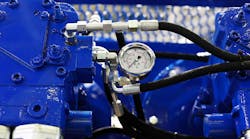Plant utilities means more than water, electricity, and natural gas. In many manufacturing operations, even air is a critical supply, though perhaps not in the way that immediately comes to mind. Ever since compressed air replaced steam power in the early 19th century, manufacturers have been finding new uses for it. Despite how much experience has been gained with compressed air, there are a few misconceptions.
One frequent misconception is that compressed-air leaks and maintenance are not maintenance priorities.
There are multiple benefits to using compressed air in manufacturing, like saving energy or having a smaller carbon footprint, but there's also some amount of maintenance cost and effort for this utility to always run smoothly. No matter what, there will always be a component of energy waste when using compressed air, but not keeping up the maintenance can make this waste much worse. If you find a leak, you need to correct the problem quickly.
Why you should fix the leak — Once you realize there's an air-compressor leak somewhere, you may think it's easier and cheaper to offset the energy loss with more energy. However, this leads to the leak getting worse in the long run.
In the United States, poorly maintained air systems cost $3.2 billion in wasted utilities annually. Back when power and energy were cheaper, it was easy to overlook the leak for a long time. Today, the opposite is true, but the cost of not fixing them is a lot worse.
Leaks also are a huge factor in the wasted energy from air compressors. Leaks sometimes cause 20 to 30% of waste from an air compressor's output. Repairing leaks, however, can lead to less than 10% of waste. Despite all this information, leaks in air compressors may lead to other operations shutting down or failing, affecting overall production. In short, fixing the leak should be an immediate priority.
Finding a leak — Realizing there's a leak and finding it are two separate problems. Common signs of an air compressor leak include a reduced air pressure or a loss of compressor power, meaning less air is going through the system. Finding the leak is the tricky part, but leaks are usually in the pistons or oil gasket, two pieces of machinery that need regular inspection.
If the leak isn't in the pistons or oil gasket, there are several other components where it could be hiding. The air hoses and tubes are the easiest places to find an obvious leak, particularly in bends. Connectors, O-rings and shutoff valves, basically anywhere the air compressor links something to another part of the machine, are other likely areas. Condensate traps and drains also may be the site of a leak.
Finally, checking the pneumatic tools may reveal an easily fixable leak, rather than one in the air compressor itself.
How to fix the leak — Stopping the leak usually is much easier than finding it in the first place. You can fix leaks by tightening connections or replacing parts. More often than not, leaks result from bad sealant, so finding those sources and applying more of, or replacing, the sealant often will stop the leak. When you find yourself fixing one of these leaks, remember to always replace materials with high-quality parts and an appropriate sealant, so another leak doesn't happen again soon.
There are two other places to look for a leak, beyond the air compressor itself. One of the primary sources could be with the tools that use the compressed air, so fixing the tool or buying a new one could be cheaper, especially if regular maintenance is occurring. The second place is in unused equipment. Sometimes, old equipment is isolated from the rest of the plant but still attached to the air-compressor system, and never receives any maintenance. Negligence could lead to a lot of problems with other equipment.
Preventing leaks — You'll want to do regular preventive maintenance to stop future problems and unscheduled shutdowns. Upkeep can be as easy as monitoring operations and checking on the equipment once or twice a month. This routine work can prevent major repairs and a lot of wasted money in the future.
Preventive maintenance also can lead to better working conditions for your employees, the use of better equipment, and may result in lower repair costs. Creating a scheduled program for maintaining leak prevention may benefit your company, too, especially after getting components tagged and implementing proper tracking procedures. If a leak happens, it's time to revamp the whole prevention program.
Stay on top — Keeping ahead of maintenance and staying vigilant about problems can save a lot of money for manufacturers. Leaks are challenging to find and sometimes expensive to fix, especially if you have to stop production. Investing an hour or so each week to check over the equipment can help everything run efficiently and save energy and cost, and result in a lot less waste in the long run.
Fixing and preventing leaks in your air compressor is a better idea than bypassing the problem completely. Leaks won't repair themselves.
Megan Nichols is a STEM writer and blogger who covers a wide range of scientific topics at schooledbyscience.com. Recently, she presented A Quick Guide to Building a Successful Metal Fabricating Business, and she described How to Optimize Your Metal Fabrication Shop. Follow Megan on Twitter @nicholsrmegan.






